Glomex USA, Shakespeare and the search for better antenna cabling systems
Recently I struggled installing a typical marine antenna with its included cable and annoying 0.71-inch (18 mm) diameter PL-259 connector. I could have cut the coax, run the cable, and attached a new PL-259, but I’m not sure that any human can install a cable connector as well as a machine, and certainly not me. That’s why it’s nice that Glomex now offers a variety of antennas and machine-made cables that use 0.35-inch (9mm) FME connectors. But for U.S. boaters, the Glomex news is better still…
While Glomex has been developing marine communications gear in Italy since 1984, now it’s established Glomex Marine Antennas USA to better serve this (huge) market. Moreover, the new Glomex USA sales manager is Chris Catoe, who for many years was the go-to guy for technical questions at Shakespeare Marine, and Chris is already happily helping with product development.
I hope to use improved Glomex availability to test some of their interesting TV, WiFi, and cellular antennas, and I’m also hoping that wider distribution of their extensive “Glomeasy” offerings will hasten the end of marine VHF, AIS, and FM antennas with awkward fixed cables and connectors.
The collage above shows how Glomex has designed various mounts to work with their FME terminated antennas, many of which include a waterproof way to feed the cable through a cabin top (see more detail in this Chris Catoe video and even more in the Glomeasy PDF). Another benefit besides an easier installation without PL-259 issues is that you can easily remove the antenna or replace a broken one.
You could also use an FME adapter from Glomex or others to upgrade most of the cable run to coax with less signal loss than standard RG-8X. Many professional installers favor LMR 400 or 240 coax and an attenuation table will show you why. But if you can afford maximum performance, check out premium sticks like Digital Antenna’s 800 series or Shakespeare’s Phase III designs, both of which feature clever double female ferrule designs that can accommodate thick extra low loss cable like LMR 400 direct to the antenna base. (Phase III detail video here, with a familiar narrator.) And if you’re a serious racing sailor, don’t miss Farallon Electronics’ UltraWhip.
Back in more modestly priced territory, there’s also Shakespeare’s QuickConnect antenna and mount system, illustrated below. It still includes a fixed PL-259 connector, so it wouldn’t have helped with my issue of fishing the cable through a smaller hole. But you won’t suffer the silliness of twisting an antenna onto a mount with a bundle of cable also in hand, and the antenna will be removable.


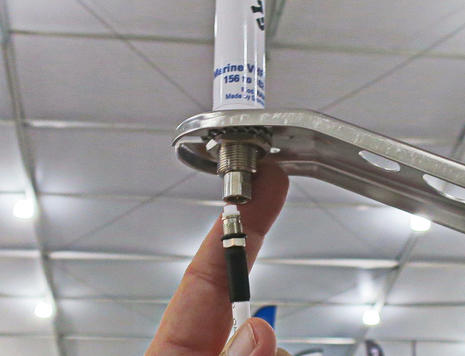
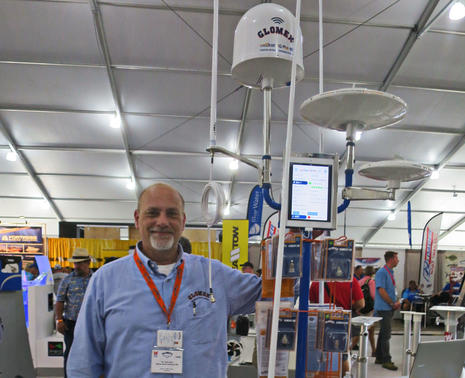
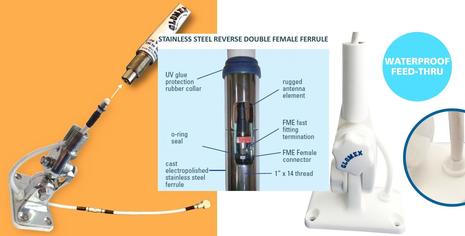
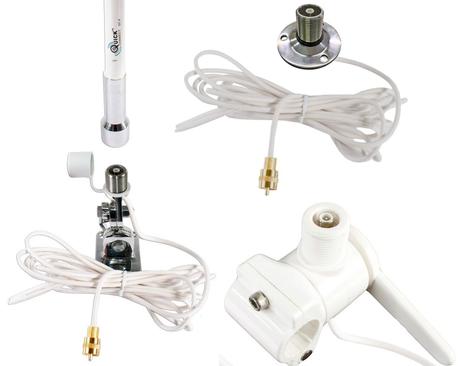



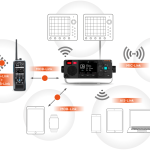







Thanks for the timely post Ben, as I’m pondering how to mount an AIS antenna and coax on my sailboat’s stern arch to my AIS Transponder. When you state “You could also use an FME adapter from Glomex or others to upgrade most of the cable run to coax with less signal loss than standard RG-8X.” I am a bit confused. I thought the FME adapters only worked with the specific FME RG8X coax?? Thanks!
The shop that I work installs thousands of coax connectors a year (TNC, Mini pl-259, SMA, Reverse SMA mostly). invariably the failed antenna connectors are ALWAYS the hand installed connections. Even with the proper tools, experience and working in a enclosed shop, mistakes are made.
I wish I could convince people that installing connectors is not a matter of pride, it only produces service calls. It certainly cost more time/money.
Hi Ted and sorry to be confusing. What I meant was that once a length of Glomex FME RG-8X is out of the antenna I think it’s fine to switch up to a different grade of coax.
So if your total run is 50 feet you could get the 10-foot Glomex and order 40 feet of LMR 400 with FME female and whatever connector your transponder needs for about $60 here:
https://usacoax.com/custom/custom-lmr-400-cable-build.html
It might be possible to run a custom cable with male FME connector up into the antenna but I’d ask Glomex first as it looks like they’ve engineered that connection tightly.
Best detail on the Glomeasy gear turns out to be here:
http://www.glomex.it/leisure/front/upload/Glomex_Glomeasy-Book_eng.pdf
So in answer to the question about using 3rd party FME connectors and cables with the Glomeasy antennas, Chris Catoe answered:
“You could use third party coax, but to maintain the waterproof integrity, I would suggest using ours. We can actually make and have longer lengths if needed.”
Thank you Ben and Chris for the additional info.
Is there any rule of thumb on coax run length that would justify the mix of coax (w/a connector) vs. using an uninterrupted run of RG-8X? My AIS antenna run will probably be
I am installing antennas made by pacific aerials, made in New Zealand, from some years ago with this system, and they are even better than the newcomers. Take a look at their webpage. They have fantastic gear that makes the installer life much more easier. You can even have a spare antenna and change it in a minute
http://www.pacificaerials.co.nz/marine
I think Navico is also using them in Europe
Thanks, Enric. Those look like a smart combination of Shakespeare’s QuickConnect and Glomex’s use of FME connectors. In fact, I’d guess that both companies got some inspiration from Pacific Aerials.
However, I think that their antennas, mounts, etc. would be quite hard to purchase in the U.S. as they only list one distributor and that distributor does not list them as one of its manufacturers.
Operating in this relatively huge and fractured market is hard. Glomex, for instance, had one very good distributor for years, but I think it really it takes a dedicated staff, a warehouse, etc. for product lines like these.
Ben,
Glomex is to be applauded for the use of FME connectors. Generally all cabling in the marine environment has been hindered in the past due to the multi-pin connector diameters. Given the ever diminishing spaces we need to pull cables through minimising physical interferences is to be applauded.
On page 2 of the UltraWhip brochure, there is a list of various cables and the maximum acceptable lengths to meet racing rules. And what is the rule? Max 40% loss which equals 15 watts delivered to the antenna. This is a good guideline. Friends and I build an excel sheet that does the calcs, so we can factor in a mix of cable sizes to meet the rules.
Connectors are always the weak link. Keep them dry, that helps a lot (look up Scotch 2242). We like male to female TNCs and FME for any VHF mid-run connection with TNCs getting the nod if weight and size are not a factor. Gone are the days of PL259 to PL259 with a barrel in the middle! Note that FME was not designed for use much above 200Mhz, though some say they are rated to 2Ghz. Any UHF and up freqs we try to use TNC.
Pacific does make some nice antennas. Quality stuff.
Thanks, Eric, valuable info!
I found this somewhat funky video about Scotch 2242 self amalgamating tape…
https://youtu.be/fJPOYCDH8wE
…but watching how well it wraps and sticks made me buy some:
https://www.amazon.com/gp/product/B00004WCCK/
Also, I notice that sell coax and connectors at Farallon:
http://www.farallon.us/webstore/index1.html?c37.html&1
Can you also make up custom cables on request?
And is there any possibility you could share that coax attenuation spreadsheet with Panbo readers ;-?
Maybe I should do a few videos, or just put a camera over the bench. Funky as it may be, the video highlighted the two pillars of success with 2242, pre-stretch before applying and snip the end to get rid of the part greasy fingers have been on. Properly applied, the stuff lasts 4 or more years, or put a wrap of white Scotch 35 tape on top and come back in 10 years.
We make custom cables every day. A lot of Iridium antenna cables, because as we know, Iridium does better with more signal strength, so cutting cables to length makes a difference. We stock TNC, FME, N, UHF etc.
We also have a new line of CANbus/N2k cables made to our spec, I’ll send you some info on that soon.
The coax loss spreadsheet had several hands in to develop. It contains publicly available info and is a tool we use to be faster with accuracy to market for our customers. A good online tool is http://www.timesmicrowave.com/calculator/
I’ve pulled cables with FME ends before and after few pull if you aren’t hella careful the plastic tips get a little bit of damage. I’m curious if that makes much of a difference to the signal however what would be very handy is a screw on protector with loop to hook the pull rope to.
Ben,
I was pretty interested when I saw Shakespeare’s QuickConnect system too, until I spoke with them about it – and was told they only offer it on their “entry-level” products and would not be expanding it to the Galaxy line or above! Good grief, more marketing genius from corporate America! I ended up using a couple of Galaxy 5200 Series VHF and AIS with “traditional” mountings…
It’s worth noting that what I’d call “midline” Digital Antenna models with fixed coax cables terminate with mini UHF connectors that are easier to fish, and include an adaptor to PL-259.
But then there’s the question of antenna quality versus value, which seems hard to understand visually or even with specifications. This Chris Catoe video — https://youtu.be/Cr-elmJj8c4 — seems like a fair overview, though he didn’t get into foam fills.
@Hannahranga Maybe tape the end of the connector before you pull it through to offer some protection. Also, I would never pull a cable by its connector, attached a pull string below the connector.
Thanks again, EMS. I tape connectors too, and sometimes push or pull cables with this fiberglass rod set:
https://www.amazon.com/Electric-Fiberglass-Wire-Pull-Rods/dp/B005LW4CFG/
It’s bendier than you might think, though I have broken sections.
Also, while LMR-400 coax looks huge, I’ve often found it easy to run because it will stay straight where you want but still bend with a little persuasion.
Haven’t tried it, but just came across what looks like a good source of made up LMR 400 “equivalent” cables, white included:
https://www.air802.com/CA400FLEX-White-Antenna-Cables-LMR-400-UF-Ultraflex-Identical/
I think that the company that figures out how to make it easy to run wires thru conduits inside a boat, up inside a mast, and then terminate them at the gear mounted aloft, should get a lifetime achievement award, and get rich, as well. I replaced my TV antenna last year, with the mast down, and it was a mess. I had to remove the upper sheaves to be able to pull off the top plate, in order to run the wiring thru a convoluted channel, in order to properly support it. Other wiring for the new LED nav lights, the Windex light, and the new LED deck light had similar issues. None of this could be done with the mast up, and it was difficult with it down on stands.
I can run network wiring all around my house with not too much pain, so it is not too difficult for me to decide to upgrade my home network/equipment, or add new capabilities. On the boat, it would be a nightmare and cost a fortune, which is why I am still using 12 year-old technology. If the boat electronics vendors want to sell more stuff, they have to make it easier for the do-it-yourselfers to run the wiring/make the connections. I absolutely dread the day that the wind instrument fails.
Most of our work is on race boats, but the principal of how to make wiring easier crosses all boat types. Easy wiring starts at the boat building level with some Forethought put into the wire runs. I usually ask designers to 2x the hole sizes, stuff always gets added, plus large holes just make for neater wiring.
We do mast wiring packages and mast wiring seems to be different every time. Over the years we have arrived at what we think is a good way to do a strain relief for a cable to hang on at the top of the mast… another video that needs to be done!
So I ordered a Glomex AIS Antenna, FME coax, in conjunction with a Vesper Watchmate Vision unit for our cruising sailboat. The GlomEasy coax was easy to pull thru and terminate. And I got a SWR of 1:1. I used that Scotch 2242 tape (thank you EMSUSA) and happy with the results. Thanks again Ben for the timely article and Chris Catoe for Glomex USA’s excellent support! Here’s a pic of the install:
https://goo.gl/photos/S1LoE36wnty72dAm7
Hi Ben. Thanks for the article and information about Glomex weBBoat. What I am curious about is that with all the different distributors available for this system, and as long it has been available in the U. S., there are only 2 reviews of the weBBoat, and both are via Amazon. As I am very much interested in the system (I was a WiriePro user until they ceased operations), so had intended to visit them at the Annapolis Boat Show this year, but they were not represented …. at the biggest boat show in the U. S. Again, curious. Any reviews you may have heard?
Hi E. Kelly, I’m pleased to report that Ben Stein has the latest Glomex Webboat 4G Plus to test alongside Winegard Connect, Shakespeare WebWatch, and other marine internet systems. But I’m not sure when he’ll get to it as he and his family are trying to get their boat down the inland waterway from Chicago to Mobile.
Incidentally, I really like the Annapolis shows — and the sailboat one probably is “recognized as the world’s largest and most prestigious sailboat show” — but there are much bigger boat shows in the U.S., like Ft. Lauderdale, Miami, and maybe even regionals like the Newport and Seattle shows. It’s really tough for companies like Glomex that serve many parts of the overall market.